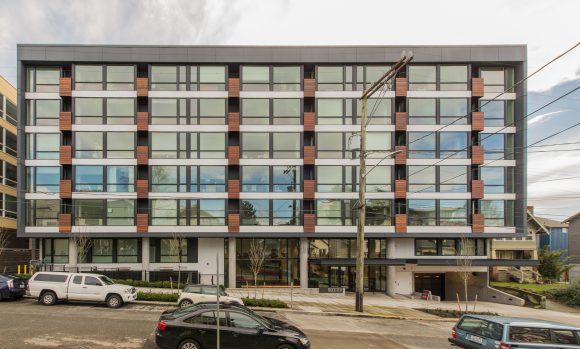
[Photo Credit: BUILD LLC]
Last autumn, BUILD sat down over drinks with Joe Ferguson and Pat Foley of real estate development firm Lake Union Partners at their Wally project in Seattle. The discussion focused on conscientious development, anchoring neighborhoods, and the challenges of creating affordable urban housing. Check out part 1 of the interview here.
What about your training or education do you attribute to being thoughtful developers?
Pat Foley: The light bulb went off for me when I was working at a firm in the Smith Tower, and our company renovated the Collins Building next door. A law firm was planning to occupy the entire Collin’s Building and we began working with Seth Howard of The Collins Pub to create a neighborhood place for all of the lawyers and other tenants in the Smith Tower to hang out. It became a neighborhood gathering place, and it’s still doing well today. At the time, Pioneer Square was on the decline and one might expect the attorney culture to be going out for drinks in a more polished and fancier place, but that was not the case. The project contributed significant T.I. dollars needed for a decent build out, and Seth really put his personality into the project. The value of having The Collins Pub in the building was really important to the overall success of the project. Even during the recession when the economy slumped, the Collin’s Pub remained busy because it has soul along with an identity and it anchors the building.
What mode do you kick into during a recession as developers?
Joe Ferguson: We’re proving that we’re scrappier than the next guy. Some of that is an interest in distinguishing our brand, our projects, and being proud of what we do. Not that this approach is recession proof, but we’re building something that has longer staying power. Because of this, we’re gaining a larger market share than you otherwise might simply from structural demand. People need housing but then there’s also choice, so we can grow our business because we’ve built a brand that stands for something. After a recession, when things start to recover and we see investment again, hopefully we’re at the top of the list. We’re fighting to be one of the top choices out there and the response that we’ve received tells us that we’ve messaged the market appropriately.

[Photo Credit: BUILD LLC]
What are the signals that tell you a project has potential?
PF: We’re contrarians by nature and discovering alternative locations early is crucial to our company. We were in places like Roosevelt and the Central District before they became cool, at least in the eyes of the development and construction lending community. Many of our competitors who laughed at us four years ago for buying property in the Central District are now themselves trying to acquire sites in that part of the city. We’re now focusing on areas like Columbia City, the International District and Beacon Hill. For the most part, we are more of a neighborhood developer, and we strategize around the first and second rings of the city. We like developing buildings that we would want to hang out at, or live in ourselves. This leads us to spend more time focusing on design issues and sourcing good local neighborhood retail.
JF: It’s also a risk mitigation strategy. It may look more pioneering at the outset, but as long as we dig into the local level with a block to block perspective and see that there’s a soul to the neighborhood and momentum in the area then we’re not vetting anything, we’re just following an established community and complementing it with great housing and retail. If the neighborhood hasn’t been over-shopped or over invested in, then we are also controlling our basis at the beginning of the project. We’re not following the herd and overpaying for land just because everybody needs to be in Capitol Hill or South Lake Union. This means that we can underwrite to lower rents and fit the neighborhood from a cost of living standpoint which gets back to livability and affordability.
Do you have any suggestions for city council with Seattle’s zoning code?
PF: I served on a sub-committee of HALA (Housing Affordability and Livability Agenda), and affordable housing in this city is a really important issue. We don’t like the idea of people who work in Seattle having to drive all the way from Everett or Federal Way because they can’t afford to live near their job in the city. We’ve enrolled projects like Wally, Rooster, 19th & Mercer, and The Central in the multi-family tax exemption (MFTE) program which works really well. Under this program, someone making $35,000 per year can afford to live in a nice building in the city. The MFTE units in our buildings lease up within a couple of weeks of being offered so there’s clearly demand. This is a real measurable benefit of the policy.
I recommend that the City Council move past the notion that rent control is a good idea. There is no evidence it has been effective in other similar sized cities. All it does is constrain supply which has the opposite effect by driving up rents for most people. This is well documented in cities like San Francisco, which is the most expensive City to live in the United States.
JF: My recommendation to the city council is stop with the single issue politics. Let’s study ideas and really put some data behind the current issues Seattle is facing. What does rent control really mean? Why are we waving the flag so hard? Let’s hit the pause button and get to some authentic analysis. People are so freaked out that our city is going to grow so quickly, that we’re not going to be able to live here. But they also shouldn’t be imposing dogmas that have the potential to shut down investment. Just because there’s anger with momentum doesn’t mean we should have a knee jerk backwards policy. Again, there needs to be a balanced approach here.
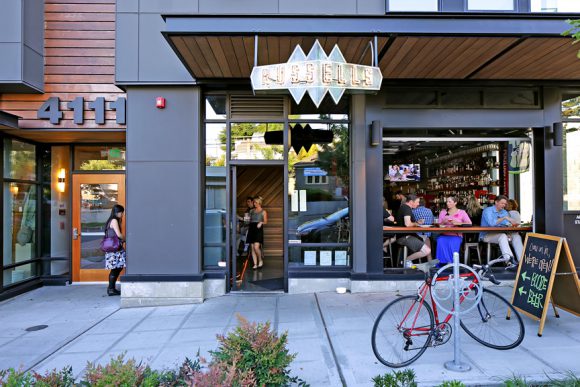
[Photo Credit: Lake Union Partners]
Even though many of your projects are located in lower rent neighborhoods, the buildings are still designed nicely. How do you maintain a consistency of good design from one set of financial variables to the next?
PF: I am convicted in the belief that new development doesn’t need to suck. We try to learn from each project we develop, and good design doesn’t necessarily cost more. There are certain details that we won’t ever deviate from, like recessing horizontal exhaust vents on the side of the buildings so that all of the required penetrations on the elevations don’t look like acne on the side of the building. This detail was introduced to us by Ed Weinstein and it’s now considered a best practice by us on all of our future development projects regardless of the architect. Another example is that cement fiber panels don’t have to look bad. If it’s not the only siding material on a project and if it’s detailed and patterned correctly, it can be great. We spend money on designing in the largest windows possible. If someone is living in a 650 square foot apartment, an 8 foot by 8 foot window makes that space feel much happier and more livable. There’s a big difference between a window that goes all the way from the floor to the ceiling, allowing the natural light to wash across the ceiling, as opposed to the standard dropped header, which feels darker and more oppressive. Designing in windows at the end of corridors allowing natural light also makes a significant difference in the experience of people living in the building. We also only allow hard surface flooring in our units because carpet can start to stink after one tenant has lived there for a while. The only place in our buildings where there is carpet is the corridors which is only there to manage acoustical quality. It’s simple things like this that don’t really cost more.
JF: We have a deep knowledge base in construction and while we don’t refer to ourselves as architects or builders, we can have very pointed conversations about how to design a really well-oiled machine that’s not necessarily going to cost more. It’s about avoiding waste so that we can put the dollars elsewhere. You see developers coming into the business from all different directions and many of them are simply investment minded. They make a lot of money but they’re missing the meat of it, they’re missing out on all these opportunities to really treat it more as a science so as to produce a better product.
Do you wish that there were more aspects of the design in your projects that the general public noticed, without having to explain it?
PF: There’s a huge effort put into the lighting and security on our projects. These features greatly affect the mood and attitude that the building is projecting and it helps people feel more welcome, comfortable, and safe even though they may not realize why.
How do you work with general contractors?
PF: One of the general contractors we recently worked with told us that we’re firm but fair and I think that fairness establishes a great deal of trust and openness. We find that people want to do a good job for us because at the end of the day they know they’re going to be treated fairly. Success to us is when a general contractor tells us that they’re proud of the project when it’s complete, even after all of the challenges.
What strategies are you putting in place to deal with the escalating permitting requirements of most building departments?
JF: Every project has different permitting and entitlement issues and it’s something we’re very strategic about. Preservation projects also require a completely different strategy. The Standard, on 1st Avenue downtown Seattle, is a historic building that we purposefully took through the entire process with the intention of having it designated as a landmark.
PF: It’s becoming more difficult and time consuming to get through the permit process so you have to be thoughtful and strategic about everything and really stay on top of it. Phased permitting is somewhat riskier but it’s the only way to achieve a reasonable review timeline at the City of Seattle right now. It also helps to do a lot of neighborhood outreach so people aren’t caught off guard by our proposal prior to Design Review. We think this improves our Land Use Review process to some degree. Plus its basic human decency to bring neighbors into the plan that is going to permanently change the appearance of their neighborhood.
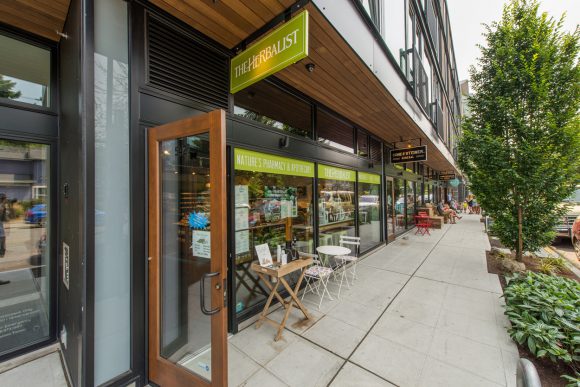
[Photo Credit: BUILD LLC]
Wouldn’t that make the permitting process more complicated and extensive?
PF: We like preservation projects and The Standard was a great opportunity to restore a building that is 122 years old. There is a tax abatement incentive on the improvements that the city provides for 10 years. There’s also scarcity for creative office space as offered at The Standard. If you want to look at it purely from a market and business perspective, there’s just very little space like that available in Seattle. You’re never going to be able to tear a building like that down, so you may as well do a really good job with it and put creative offices above with great retail at the street level.
JF: Another important factor with The Standard is its smaller footprint of 6,000 square feet. At this size, it’s much more cost effective to keep what’s there and maybe add on another story versus pretending to tear it down and start from scratch. As long as the investors understand that logic, you’ve got a good business plan.
Are there other cities in the world that you look to as examples of affordable housing?
JF: We’ve been working with the University of Washington and Pat’s now leading the winter term program in commercial real estate through the college of built environments. It’s a means to bring in working professionals from a variety of disciplines to learn the development business.
I recently got involved in the Runstad Center for Real Estate Studies at the University of Washington and I was asked to be an associate fellow. We went to South America for two weeks to study the resiliency of cities. It’s a broad topic but it allowed us to interpret it in a way that’s pointed back to Seattle. We chose to study housing affordability and livability in Santiago, Chile, Rio de Janeiro, Brazil, and Curitiba, Brazil and spent 14 days cramming meetings in with architects, urban planners, politicians, and developers. We tried to figure out what, in these countries that desperately want to be first world, are the decisions they’re making that inspire in a way what we are trying to do in Seattle. We produced a travelogue video and did a presentation back to the Runstad Center. I came back from that experience with this personal interest and motivation to see if Lake Union Partners, as a for profit developer, could be a part of this solution and pursue low income housing tax credits. The government has a structure whereby non-profit housing developers can provide affordable housing. Why can’t for-profit-developers also do the same and maybe deal with less bureaucracy? This way, affordable units could be delivered more efficiently and for-profit-developers could be part of the solution. This comes back to HALA which is a call to the for-profit world in saying that the non-profits can’t do it alone and we need to be more holistic in our thinking. What’s been so interesting is how polarized that world is. If you’re for-profit, you’re playing the evil villain afraid of Occupy Wall Street. If you’re a non-profit, then somehow it’s your sole responsibility to save the world, and yet the reality is neither can do it alone.
How is the press treating developers out there?
PF: Some developers deserve the hard time they get but most don’t. I think it’s politically popular for some in the press to paint developers as greedy A-holes because rents are increasing. What’s frustrating to us is that there are so many other factors that aren’t accurately researched and reported on, such as inflation in construction and municipal costs, along with high paying job creation, and positive in-migration. 60,000 people moved to the Seattle area last year which drives competition for housing and office space. It’s a supply and demand issue.
JF: It’s similar to how retail shop owners live and die by Yelp. The majority of people who log on to blogs just want to complain. The majority of people that have a good experience aren’t as likely to make the effort to document their experience.
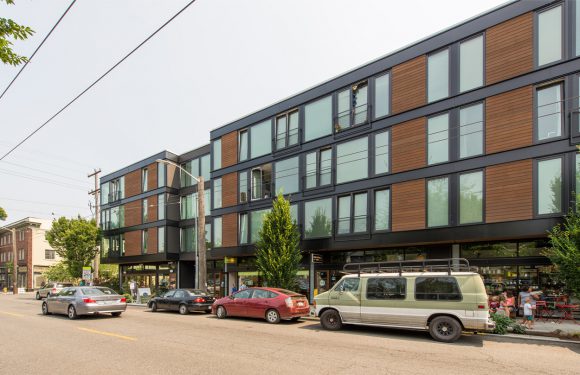
[Photo Credit: BUILD LLC]
What is your stance on sustainable design, LEED certifications, and building green?
JF: The green question is really difficult for us and when people ask us about sustainable features in our projects, it usually feels like a loaded question. We’re typically more curious to address the real motivation of the concern. It’s really about energy usage. Not just what the City requires, which is stringent, but all of the factors on top of that. We can usually address those concerns by talking about how we’re addressing energy issues at the commercial level. For instance, outfitting an entire building with LED lights has a significant impact to the energy reduction of a project.
PF: Strategies like this also lower the operational costs for the tenants. We’ve taken surveys in our various buildings and found that the average electricity bill is about $25 per month, which is pretty cheap. We would rather spend time on initiatives that are meaningful for our tenants as it relates to the overall affordability of an apartment rather than provide a plaque in the lobby telling them how green we are.
JF: LEED, in its infancy, was driven by a true motivation to study what the environmental impacts of these buildings are, which is a good, holistic thing. It’s data, it’s quantifiable, and corporations can understand it. But it also created an industry of consulting and fee based system checks, and a lot of stuff that looks to be somewhat wasteful. In working with the LEED system, we often find ourselves asking, wait, why are we doing this again, what is the intent here? Within many corporations, you see a sustainability requirement which often means in part checking the box for LEED buildings. It’s a way to please stock holders and recruit talent. We get that all of these things move the economy and the market, but we wrestle with it. Are we really doing something better, or is it just green-washing? Industries like LEED are so large now that they need to be fed, they’re quasi-governmental.
As a forward thinking development company, how are you dealing with the automobile?
PF: One way is by including a nearly one to one bike parking ratio in our projects. We carve out bike parking into a project wherever we can get it. We’ll often give up car parking stalls to provide bike parking in the garages of our projects. However, we are realists and recognize that people will always have cars at some level. Even if they take public transit or ride their bikes to work, they still need a place for a car to go places on evenings and weekends so we strive to offer at least a .5 parking ratio in our buildings. Neighborhoods are right to be pissed when there is zero parking in a new building just because it’s City policy. Sometimes parking isn’t possible but I think we should always try our best to provide some so people who have lived in their neighborhood for years can actually park in front of their house.
JF: Rooster is a good example because light rail is coming, but it’s not there yet. It creates an interesting conversation about what it means to open the building in 2015 when the light rail station won’t be open until 2021. There’s a significant gap there. We don’t want to develop the building with one parking stall per unit in a transit oriented neighborhood and in station overlay district, but the building will also have to lease up, stabilize, and thrive. So we pointed to the fact that there are 14 bus lines within a five block radius servicing the Seattle Metro Area which got us comfortable at a 60% ratio of parking stalls to units.
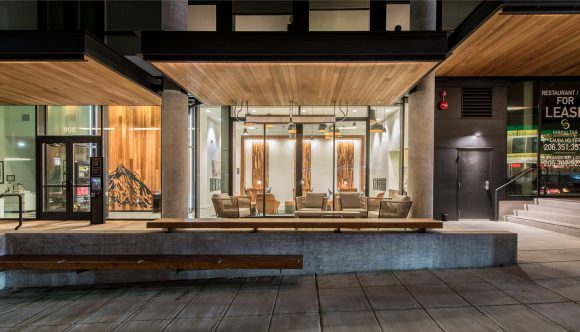
[Photo Credit: BUILD LLC]
Have there been any recent influences to your thinking on urbanism?
JF: Plymouth housing just held their annual luncheon and I went to see their speaker, Bryan Stevenson, who runs the Equal Justice Initiative. I highly recommend Stevenson’s TED talk as well as his book called Just Mercy which is all about the bigger issue in our society that one in three black men and one in six Latinos will be incarcerated at some point. You start to think about the cause of these issues. Is it our society, is it the built environment? Stevenson is brilliant at distilling the issues and I was inspired by this idea of Stevenson’s that we all need to “get proximate” to the issue. Don’t just write a check to the organizations you want to support, but take action on something.
PF: There is a 1984 documentary called Streetwise by director Martin Bell which was filmed in Seattle. You can watch it on YouTube and it’s a super-raw look at homeless street kids in Seattle in the 1980s. We stumbled across it when researching the Eitel building at 2nd and Pike St., where these kids used to hang out. It’s been a call to action for us, in the spirit of the Bryan Stevenson philosophy. We’re asking ourselves how we can make a difference with homeless youth downtown. We have been asking ourselves if there is there a way to compel our contemporaries in the industry to take a personal interest in the issues of our city. How can people make a meaningful difference in the lives of forgotten street kids? How can they take the leap and get proximate?
Joe Ferguson leads Lake Union Partner’s acquisition and capital development efforts and guides the firm in creating effective real estate investment opportunities. Joe is an associate fellow of the Runstad Center for Real Estate at the University of Washington and serves on the National Advisory Board for the University of Colorado Real Estate Center.
Pat Foley focuses on project vision and the execution of the development business plan for Lake Union Partners. He has an extensive background in preservation and adaptive reuse projects and urban infill development. Pat oversees the development strategy from concept through underwriting and stabilization, and leads project team selections. Pat is an instructor during the winter term in the University of Washington’s Commercial Real Estate Certificate program.





